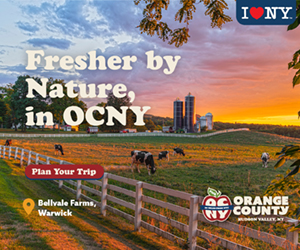Chardonnay is the noble grape variety that originally hails from Burgundy, France. It is believed by some to be an accidental or intentional hybrid that was propagated by local Burgundian growers, and is a cross of a Pinot Noir clone and the bulk wine/table grape known as Gouais. Chardonnay is very similar to the versatile white wine grape Seyval Blanc, the French-American hybrid that is also grown widely in the Hudson Valley.
Of all the viniferas, Chardonnay is probably the easiest to grow, in that it is tolerant of most soil types and is a mid-season variety that ripens early. A moderately productive grape with medium-sized clusters, Chardonnay is just as reliable a producer in warm and dry years, as it is in the more challenging years that are cold and damp. In most seasons, Chardonnay can produce adequate sugars so that quality does not widely vary from year to year.
Along with Riesling, Chardonnay is one of the most winter-hardy of the white viniferas grown in the Hudson Valley. Unlike Riesling, which ripens late to very late in the fall (around middle of October), Chardonnay ripens much earlier, around the third week of September. Its relatively early ripening time helps it to avoid the autumn rains which inevitably come, bringing a host of fungus problems to the growers’ harvest experience. And, if the season is cool and the grapes are ripening later than usual, there is time for Chardonnay to ripen properly before the first fall frost.
In the cellar, Chardonnay has good balance, sufficient sugars, and flavors that are not too weak or overbearing. Thus, it is very versatile and can be made into sparkling wines; big, fat, buttery wines full of vanilla; austere, flinty wines of great intellect; or easy-drinking table wines.
Chardonnays produced in the Hudson Valley can be made in a French Chablis style—wines that are steely, crisp, lean, flinty, and acidic, with fruits of green apples, lemons, and grapefruit. The Hudson Valley has the perfect climate and soils to make these leaner style Chardonnays and sparkling wines. It can also be made as a subdued version of a big, California-styled, round and oaky wine, with rich textures and intense aromas and flavors of butter, vanilla, melons, pears, tropical fruits, old bananas, and nuts, like almonds and hazelnuts. Or, it can be made into barrel-fermented, aged sur lie wines—layered wines that are yeasty, warm, and creamy, and brightly flavored with elements of ripe apples, melons, pears, soft lemons, and vanilla. Naturally, because of the great range of styles, it is a popular wine that is generally liked by consumers.
Just as the types of wine made from Chardonnay are wide and varied, so are its. They range from pale, light yellow and pale, green-yellow, to straw and light gold colored.
There are different clones of Chardonnay that can be utilized in the Hudson Valley based on the vineyard site and types of wines to be produced. The time is right for the Valley’s winemakers to begin to create their own unique contribution to the development of new Chardonnay styles, or to augment already existing ones.





